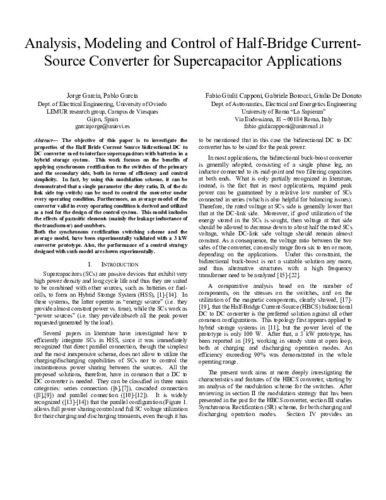Analysis, modeling and control of half-bridge current-source converter for supercapacitor applications
Autor(es) y otros:
Palabra(s) clave:
DC-DC power convertors
Supercapacitors
Switching convertors
Fecha de publicación:
Editorial:
IEEE
Versión del editor:
Descripción física:
Resumen:
The objective of this paper is to investigate the properties of the Half Bride Current Source bidirectional DC to DC converter used to interface supercapacitors with batteries in a hybrid storage system. This work focuses on the benefits of applying synchronous rectification to the switches of the primary and the secondary side, both in terms of efficiency and control simplicity. In fact, by using this modulation scheme, it can be demonstrated that a single parameter (the duty ratio, D, of the dc link side top switch) can be used to control the converter under every operating condition. Furthermore, an average model of the converter valid in every operating condition is derived and utilized as a tool for the design of the control system. This model includes the effects of parasitic elements (mainly the leakage inductance of the transformer) and snubbers. Both the synchronous rectification switching scheme and the average model, have been experimentally validated with a 3 kW converter prototype. Also, the performance of a control strategy designed with such model are shown experimentally
The objective of this paper is to investigate the properties of the Half Bride Current Source bidirectional DC to DC converter used to interface supercapacitors with batteries in a hybrid storage system. This work focuses on the benefits of applying synchronous rectification to the switches of the primary and the secondary side, both in terms of efficiency and control simplicity. In fact, by using this modulation scheme, it can be demonstrated that a single parameter (the duty ratio, D, of the dc link side top switch) can be used to control the converter under every operating condition. Furthermore, an average model of the converter valid in every operating condition is derived and utilized as a tool for the design of the control system. This model includes the effects of parasitic elements (mainly the leakage inductance of the transformer) and snubbers. Both the synchronous rectification switching scheme and the average model, have been experimentally validated with a 3 kW converter prototype. Also, the performance of a control strategy designed with such model are shown experimentally
ISSN:
Patrocinado por:
This work has been partially funded by the Campus of International Excellence (CEI) of the University of Oviedo, Spain, in the framework of Mobility Grants for Academics in 2013, partially funded by the Gijon City Hall, by resolution of BOPA 156, 6-VII-2013. This work has also been partially supported by the Spanish Government, Innovation Development and Research Office (MEC), under research grant ENE2013-44245-R, Project “Microholo”, and by the European Union through ERFD Structural Funds (FEDER)
Colecciones
Ficheros en el ítem




